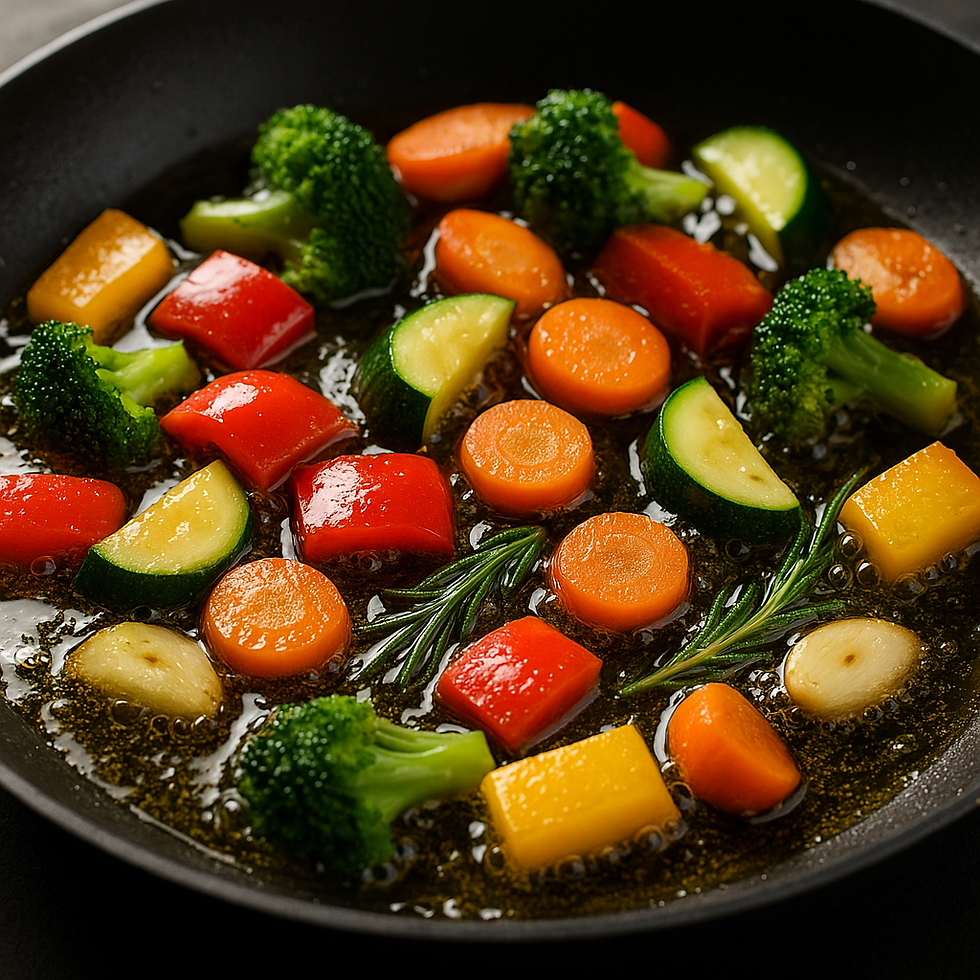🌿 Healthy Cooking Oils: How to Choose the Right One for Every Dish
- Eutierria Essence
- Jun 12
- 7 min read

Cooking with oils is more than just picking something slick to keep your food from sticking. It's about nourishment, flavor, and honoring your ingredients. The oil you choose can elevate a dish or undermine its health benefits. With so many options out there, knowing which oils are truly wholesome and which to avoid can feel overwhelming.
In this post, we’ll walk through some of the healthiest oils to cook with, which ones to use with care (or not at all), and how to match the right oil to your meal. Whether you’re sautéing vegetables fresh from the garden or finishing a dish with a drizzle of something special, consider this your guide to cooking with intention.
🔥 First, Know Your Smoke Point

Every oil has a smoke point the temperature at which it begins to smoke, break down, and form potentially harmful compounds. Heating an oil beyond its smoke point can destroy nutrients and impart bitter flavors.
High-heat cooking: Choose oils with high smoke points (above 400°F)
Medium-heat cooking: Use oils with moderate smoke points (350–400°F)
Cold applications or finishing: Use oils with lower smoke points and high nutrient content
Healthy Oils to Reach For:

🫒 1. Extra Virgin Olive Oil (EVOO)
Best for: Drizzling, dressings, low to medium sautéing
Smoke point: ~375°F
Flavor: Fruity, grassy, sometimes peppery
Rich in monounsaturated fats, EVOO supports heart health and reduces inflammation. It contains polyphenols antioxidants that protect cells from oxidative stress and has been linked to better brain function and reduced risk of chronic diseases. Cold-pressed and unrefined, EVOO is as close to nature as oil gets.
✨ Best used raw or gently warmed to keep its full nutritional value intact.
🥑 2. Avocado Oil
Best for: Frying, grilling, roasting
Smoke point: ~520°F
Flavor: Mild, buttery
A champion for high-heat cooking, avocado oil won’t break down easily under pressure. Nutritionally similar to olive oil, it’s full of vitamin E, lutein, and anti-inflammatory monounsaturated fats. It’s a clean, neutral-flavored oil perfect for everything from stir-fries to seared meats.
🔥 When you need heat and health, avocado oil is a reliable ally.
🥥 3. Coconut Oil
Best for: Baking, curries, light frying
Smoke point: ~350°F (unrefined), ~450°F (refined)
Flavor: Sweet, nutty (unrefined); neutral (refined)
Coconut oil is rich in medium-chain triglycerides (MCTs), which are metabolized quickly for energy and may support cognitive function. It also contains lauric acid, known for antimicrobial properties. That said, it’s high in saturated fat, so it’s best used in moderation and rotated with other oils.
🥥 Excellent for baked goods or adding a tropical flair to dishes.
🌰 4. Walnut Oil
Best for: Finishing, vinaigrettes, chilled dishes
Smoke point: ~320°F
Flavor: Rich, slightly bitter, nutty
Walnut oil is a plant-based source of omega-3 fatty acids, particularly ALA, which supports brain and cardiovascular health. It's also high in antioxidants and minerals like magnesium. Due to its low smoke point, it's best kept off the stove.
🌿 Drizzle over roasted root vegetables or leafy greens for a rich finish.
🌿 5. Flaxseed Oil
Best for: Smoothies, dressings, raw dishes
Smoke point: ~225°F
Flavor: Grassy, slightly earthy
Flaxseed oil is one of the highest sources of plant-based omega-3s, vital for hormone balance, heart health, and reducing inflammation. Highly sensitive to heat, light, and oxygen it must be refrigerated and never cooked.
💧 Add to a smoothie or mix with lemon juice and herbs for a nutrient-packed salad dressing.
🍃 6. Hemp Seed Oil
Best for: Dips, grain bowls, finishing oil
Smoke point: ~330°F
Flavor: Earthy, grassy, slightly nutty
Hemp seed oil contains a perfect ratio of omega-6 to omega-3, which can help reduce inflammation and support skin and joint health. It’s also rich in GLA (gamma-linolenic acid), a rare anti-inflammatory compound.
🌾 Use in creamy dips, avocado toast, or as a vibrant drizzle for soups.
🍇 7. Grapeseed Oil
Best for: Searing, sautéing, roasting, baking Smoke point: ~420°F
Flavor: Neutral, light, slightly nutty
Why it’s healthy (in moderation):Grapeseed oil is extracted from the seeds left over from winemaking, making it a sustainable byproduct. It has a relatively high smoke point and a neutral flavor, making it very versatile in the kitchen. It’s high in polyunsaturated fats, particularly omega-6s, and contains some vitamin E.
However, because of its high omega-6 content, balance is key especially in Western diets that already tend to be omega-6 heavy and omega-3 deficient. When omega-6 fats greatly outweigh omega-3s, they may contribute to chronic inflammation.
🍳 Grapeseed oil is great for occasional use when you need a neutral, high-heat oil—but it shouldn’t be your primary fat source. Pair it with omega-3-rich foods or oils like flaxseed, walnut, or hemp to stay balanced.
🌾 8. Sesame Oil (Refined & Toasted)
Best for: Stir-fries, sauces, marinades, finishing
Smoke point: ~410°F (refined), ~350°F (toasted)
Flavor: Nutty, warm, intense (especially toasted)
Why it’s healthy: Sesame oil, especially unrefined or cold-pressed, is rich in antioxidants like sesamol and sesamin, which are known to support cardiovascular health and reduce oxidative stress. It also contains a mix of polyunsaturated and monounsaturated fats, making it a heart-friendly option in moderation.
Toasted sesame oil, while lower in nutrients due to roasting, brings deep flavor and is used sparingly often more like a seasoning than a base oil.
🍜 A wonderful addition to Asian-inspired dishes, sesame oil is best used for flavoring or finishing not as your everyday cooking oil.
🥜 9. Peanut Oil (Refined & Unrefined)
Best for: Frying, stir-fries, grilling
Smoke point: ~450°F (refined), ~320°F (unrefined)
Flavor: Mild and neutral (refined), nutty and rich (unrefined)
Why it’s healthy (in moderation):Refined peanut oil is a popular choice for high-heat cooking due to its high smoke point and clean flavor. It's a good source of monounsaturated fats, which support heart health, and has a decent balance of saturated and polyunsaturated fats. It also contains resveratrol, an antioxidant more famously found in red wine.
Unrefined peanut oil has a much bolder flavor and lower smoke point, making it better for cold applications or low-heat cooking. While peanut oil can be part of a healthy diet, it is relatively high in omega-6 fats, which can be pro-inflammatory when not balanced with omega-3s. Also, some people may need to avoid it due to peanut allergies.
🔥 A great option for the occasional deep-fry or crispy stir-fry, especially if paired with omega-3-rich ingredients elsewhere in your diet.
⚠️ Oils to Use with Caution (or Not at All)
Some oils are best used sparingly or avoided entirely due to how they’re processed and their effects on health over time.
🚫 1. Vegetable Oil Blends
These are often made from soy, corn, or canola and highly refined using chemical solvents like hexane. They're also typically high in omega-6 fatty acids, which, in excess, can contribute to systemic inflammation especially when out of balance with omega-3s.
🧪 The lack of transparency and heavy processing make these oils a poor everyday choice.
🚫 2. Corn, Soybean, and Cottonseed Oils
These oils are commonly found in processed foods and fried restaurant meals. They are:
Often genetically modified
Extremely high in omega-6 fats
Chemically refined and stripped of nutrients
They may contribute to oxidative stress and long-term inflammation, especially when consumed frequently.
❌ These oils are best limited or eliminated for those pursuing a natural, anti-inflammatory lifestyle.
⚠️ 3. Canola Oil
Canola has a complicated reputation. While canola oil contains heart-healthy monounsaturated fats, most commercial versions are highly refined using high-heat and chemical processes that strip away nutrients and may create small amounts of trans fats. Additionally, most canola crops are genetically modified not necessarily harmful in themselves, but a concern for those seeking minimally processed, non-GMO options. Small amounts of cold-pressed, organic canola oil may be fine, but it’s not the top choice for health.
💡 Use only if organic and cold-pressed, and rotate with better options like avocado or olive oil.
🧑🍳 Matching Oils to Cooking Methods
Dish Type | Best Oil Choice | Why |
Stir-fries | Avocado, Peanut | High smoke point, mild flavor |
Salad Dressings | Olive, Walnut, Flaxseed | Flavorful, nutrient-rich oils |
Deep Frying | Avocado, Refined Coconut | High heat stability |
Roasted Veggies | Olive, Grapeseed | Flavorful, withstands heat |
Baked Goods (Sweet) | Coconut, Light Olive | Adds texture and sweetness |
Baked Goods (Savory) | Avocado, Grapeseed | Neutral taste, stable fat |
Finishing Drizzle | Hemp, Sesame, Walnut | Adds nutrition and bold taste |
🏡 Tips for Cooking & Storing Oils
Store in dark glass bottles in a cool cupboard (or fridge for flaxseed/hemp oils)
Avoid plastic containers which can leach chemicals
Don’t let oils sit open on the stove heat and light degrade quality
Rotate your oils to get a diversity of fats and nutrients
Use smaller bottles if you cook infrequently to preserve freshness
🌱 At Eutierria Essence, We Believe…

…that every choice in the kitchen is a step toward better health or away from it. The oils you use daily aren't just ingredients they’re building blocks for your body, your energy, and your long-term well-being.
You deserve better than what’s cheap, refined, and stripped of nourishment.
So the next time you reach for a bottle, ask yourself: Is this feeding my body or just filling the pan?
Choosing the right oils isn’t about following a trend. It’s about protecting your heart, nourishing your cells, and creating meals that truly support your life.
👉 Start with one switch maybe it's swapping out that vegetable blend for cold-pressed olive oil, or tossing a teaspoon of flax oil into your smoothie. Small changes lead to powerful shifts.
Your health is worth it.
Your meals are sacred.
And every drizzle, every sizzle, is a chance to choose wellness on purpose.




Comments